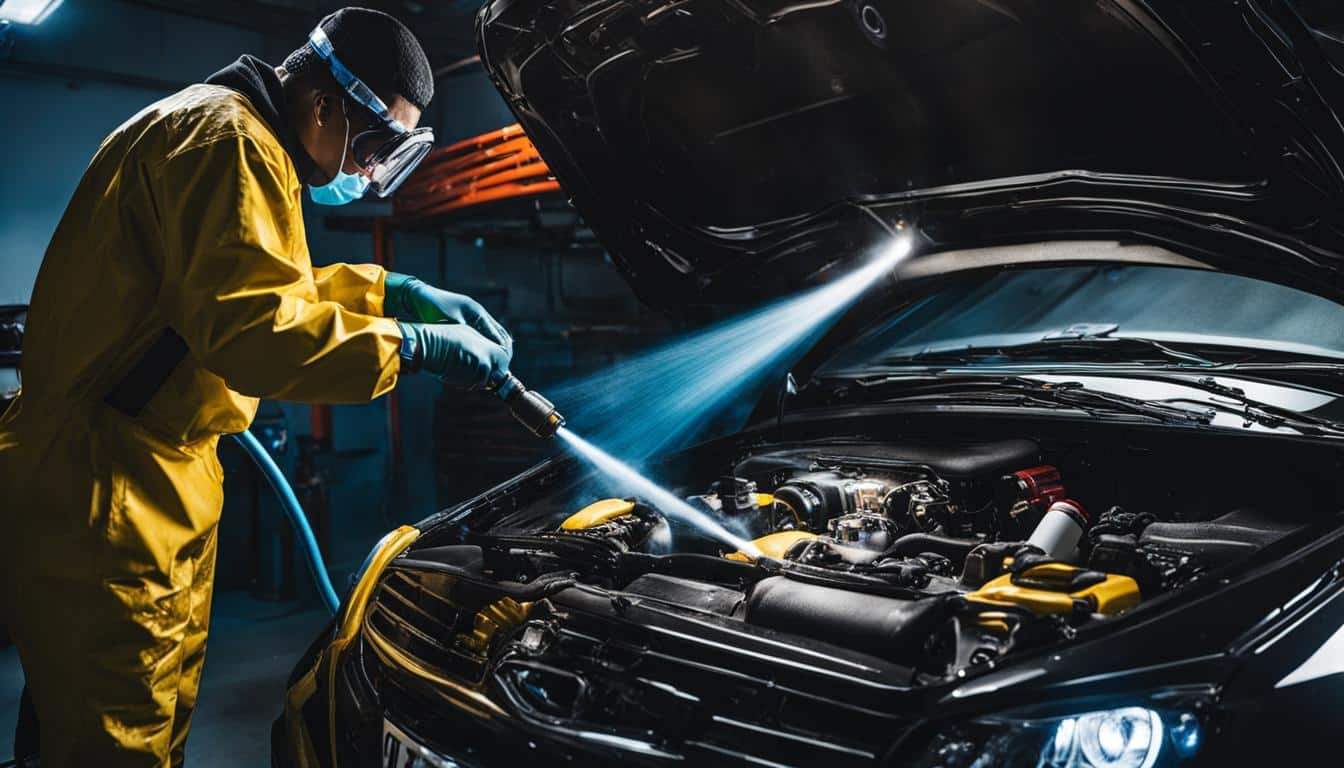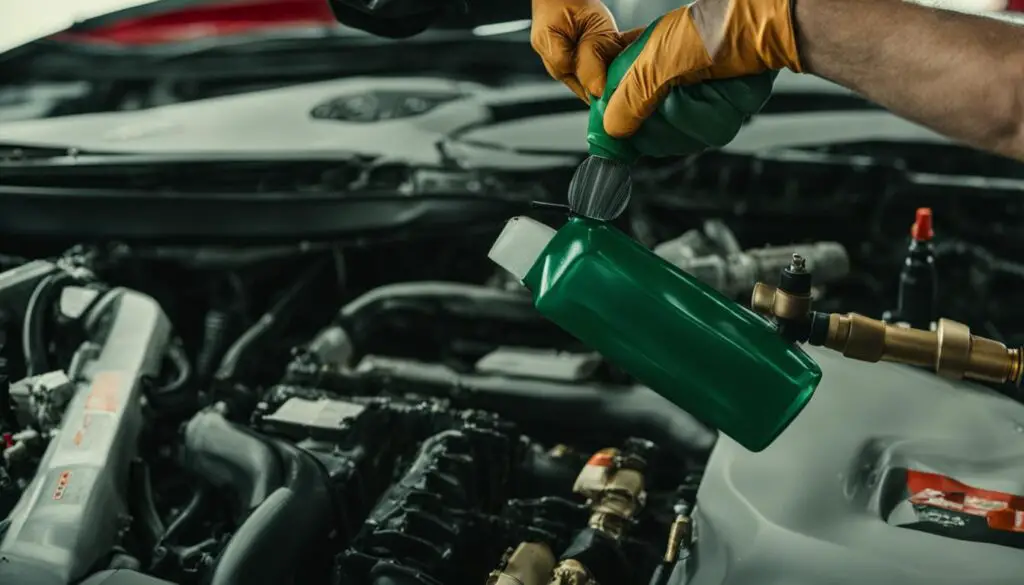
How to Effectively Clean Your Car’s Engine Bay
Keeping your car’s engine bay clean is crucial to maintain its longevity and enhance its appearance. A clean engine bay not only improves your vehicle’s performance but also increases its value. However, most car owners overlook this essential aspect of car maintenance, leading to corrosion, rust, and grime buildup. In this section, I will provide you with expert cleaning car engine bay tips to help you maintain your vehicle’s performance and appearance.
Before cleaning your engine bay, you must ensure that your car’s engine is cold and not running. A hot engine can cause damage to the electrical components. You should also cover sensitive components like the air intake, electrical connectors, and fuse boxes to prevent water damage.
Here are some engine bay cleaning steps you should follow:
- Start by removing the debris and loose dirt with a soft-bristled brush or compressed air.
- Apply a degreaser or an engine cleaner and let it sit for a few minutes.
- Use a soft-bristled brush or microfiber cloth to scrub the engine bay surfaces gently.
- Rinse off the cleaning solution with a hose or pressure washer gently.
- Dry the engine bay completely with a clean microfiber towel.
- Apply a protectant or engine dressing to prevent rust and corrosion.
These engine bay cleaning steps will help you achieve a thorough cleaning process and proper car maintenance.
Key Takeaways
- Maintaining a clean engine bay is crucial for car maintenance and enhances your car’s appearance.
- Before cleaning your engine bay, make sure that your engine is cold and not running.
- Cover the sensitive components to prevent water damage.
- Use a degreaser or an engine cleaner to remove grime and dirt.
- Apply protectant or engine dressing to prevent rust and corrosion.
DIY Engine Bay Cleaning: Step-by-Step Guide
Keeping your car’s engine bay clean and well-maintained is crucial to ensure its longevity and performance. Here’s a step-by-step guide on how to clean your car’s engine bay effectively:
Gather Your Supplies
Before you get started, ensure you have all the necessary engine bay cleaning products readily available. Some essential supplies include:
- Engine degreaser
- All-purpose cleaner
- Bristled brush
- Microfiber towels
- Water hose
- Plastic bags
Ensure these supplies are safe for use on your car’s engine bay before beginning.
Cover Sensitive Areas
Protect sensitive areas in your engine bay from direct contact with water by covering them with plastic bags. These areas may include the fuse box, air intake, and battery terminals. Be careful not to cover any hot surfaces that may cause the plastic to melt.
Apply Engine Degreaser
Apply the engine degreaser on the surface of the engine bay and allow it to settle for a few minutes. Use a bristled brush to scrub away any stubborn grime and dirt from the surface. Take extra care not to use too much water when cleaning the engine bay.
Clean with All-Purpose Cleaner
Once the engine degreaser has been washed away, use an all-purpose cleaner to clean the remaining dirt and grime. Wipe the surface clean with a microfiber towel, ensuring all areas are thoroughly cleaned. Avoid cleaning electrical components and sensitive areas.
Rinse and Dry
Rinse away the all-purpose cleaner with a water hose, taking care not to use high-pressure water on sensitive components. Wipe down the engine bay with a microfiber towel and allow it to air dry completely. Avoid starting the car until the engine bay is completely dry.
Final Touches
Apply a protectant to the plastic and rubber components in the engine bay to prevent any cracking or fading. Check the oil levels and fill up if necessary. Inspect your engine bay for any damages or leaks and seek professional help if required.

Car Engine Detailing: Tips for a Pristine Engine Bay
If you want your car’s engine bay to look like it just rolled out of a showroom, then you need to pay attention to car engine detailing. Engine bay cleaning is not just about removing dirt and grime, it is also about maintaining a polished appearance. Here are some expert tips on car engine detailing to help you achieve a pristine engine bay:
Clean the engine bay thoroughly:
The first step in car engine detailing is to clean the engine bay thoroughly. Use an engine bay cleaning guide and wash the engine bay with a degreaser. After that, rinse it off with water and let it dry. Make sure to cover any electrical system components before cleaning to avoid any damage.
Polish the engine:
After cleaning the engine bay, it’s time to polish it. Use a suitable engine polish and apply it evenly on the engine surfaces. Use a microfiber cloth to rub the polish into the engine bay. Make sure to remove excess polish and buff it to a high shine.
Apply a protectant:
Once you have polished the engine, apply a protectant to prevent any future damage. You can use a silicone-based protectant spray or a suitable engine bay dressing for this purpose. Apply the protectant evenly on the engine surfaces using a clean cloth or applicator. Make sure to avoid getting it on any electrical system components.
Clean the engine regularly:
Car engine detailing is not a one-time job. You need to clean the engine bay regularly to maintain its pristine appearance. Use an engine bay cleaning guide to ensure you are using suitable products and techniques to clean it properly. Regular cleaning and maintenance will not only keep your engine bay looking good but also prevent any damage to the engine.
Following these tips for car engine detailing will help you achieve a pristine engine bay that will make your car stand out from the rest. A clean engine bay is not only aesthetically pleasing but also improves the longevity of your vehicle.
FAQ
How often should I clean my car’s engine bay?
It is recommended to clean your car’s engine bay at least once every six months or whenever visible dirt and debris accumulate. Regular cleaning will help maintain the longevity and performance of your engine.
What products should I use to clean my car’s engine bay?
When cleaning your car’s engine bay, it is best to use a degreaser specifically designed for automotive engines. Avoid using household cleaning products as they may damage sensitive engine components. Additionally, make sure to have a soft brush, microfiber cloth, and a gentle hose sprayer for a thorough and safe cleaning process.
Do I need to protect sensitive components before cleaning the engine bay?
Yes, it is crucial to protect sensitive components such as electrical connections, air filters, and intake systems before cleaning the engine bay. Cover these parts with plastic bags or waterproof covers to prevent water or cleaning products from causing damage. Also, avoid spraying directly onto these components and use caution when rinsing to prevent water intrusion.
Can I clean my engine bay with the engine running?
No, it is not recommended to clean your engine bay with the engine running. Turn off the engine and let it cool down completely before starting the cleaning process. Cleaning with the engine off ensures safety and prevents potential damage to yourself or the vehicle.
Should I disconnect the car battery before cleaning the engine bay?
It is generally not necessary to disconnect the car battery when cleaning the engine bay. However, if you’re planning to use a pressure washer or any high-pressure cleaning equipment, it is advisable to disconnect the battery as a precautionary measure to avoid any electrical mishaps. Always refer to your vehicle’s manual for specific instructions regarding battery disconnection.
Are there any areas I should avoid when cleaning the engine bay?
Yes, there are certain areas you should avoid when cleaning the engine bay. These include electronic components, exposed wiring, and delicate sensors. Use caution around these areas and avoid excessive water or cleaning product contact. If unsure, consult a professional or refer to your vehicle’s manual for guidance.
Can I use a pressure washer to clean my car’s engine bay?
While a pressure washer can be used to clean the engine bay, it is essential to exercise caution. Use the lowest possible pressure setting and maintain a safe distance from sensitive components. High-pressure water can potentially damage electrical connections, intake systems, and other delicate parts. If you’re unsure about using a pressure washer, it is recommended to stick to manual cleaning methods.
Are there any post-cleaning steps I should follow?
After cleaning your car’s engine bay, it is crucial to let it dry thoroughly before starting the engine. Ensure that all areas are free from moisture, especially around electrical connections and sensitive components. Additionally, take the time to inspect the engine bay for any signs of leaks, loose wires, or other abnormalities. If you notice anything unusual, consult a professional mechanic for further evaluation.
